Reconstructing a process variable of interest (like the flow rate or composition) from the scaled transmission signal typically involves several conversions and interpretations. Those who will be structuring the signal processing and calculations within data acquisition and control systems should understand the interpretation and reconstruction of the process variable (PV) value from the transmission received in the control room, and the issues associated with device calibration and digital discretization.
Consider a classic orifice flow measurement. The process variable (PV) is volumetric flow rate, , perhaps it has a value of 430.1 gal/min. The orifice creates a differential pressure drop, DP, which ideally is proportional to flow rate squared. The corresponding DP might be 3.602 psig. The flow sensor measures the DP, not the . But ideally, from the DP one can infer the flow rate—one can calculate from DP using the orifice equation. The orifice device creates a sensed variable (SV) which is easily measured.
Then a transducer transmits a 4-20 mA current signal to the control room. The value may have a value of 11.145 mA, representing the 3.602 psig value. Finally, an analog-to-digital device converts the to a digital count, perhaps between 200 and 800. The ideal count of 467.9375 must be truncated to 467, which will be reported as 11.120 mA, which will become a distortion of the calculated PV value, even if every other calibration idealization were true. But, none of the calibrations are exactly perfect, and the model relating the SV to the PV is not exactly true either.
The questions are about how to convert the digital representation of the transmission scaled signal value back to the PV value for display/monitoring/control, how to calibrate the several devices in the signal transmission steps, how to determine the impact of the digital discretization and calibration imperfection, and how all this shapes the calibration protocol and selection of digital devices.
The situation is not exclusive to flow rate measurement. Composition is not directly measured, but a related property is, a sensed variable. This SV might be near-infrared light intensity, electrical conductivity, or electrical millivolt; and the transducer (sensor/transmitter) will be reporting a signal that is ideally proportional to the SV, not the composition.
Similarly, level is not measured, but the consequential differential pressure or electrical capacitance might be. Temperature is not measured, but the associated SV, thermocouple mV or RTD resistance, is. Density is not measured, but the related vibration harmonic frequency can be. Some of the relations between the PV and the sensed property are linear, but many are nonlinear.
Additionally, the situation is not exclusive to systems that transmit electric current signals as 4-20 mA. If the transmission signal is pneumatic, it has a nominal 3-15 psig range of values, if volts, it has a nominal 1-5 V range, and many digital transmissions are reported in the 0-100% ideal range. Such transmitted signals are usually linearly related to the sensed property, the SV. There may be several linear transmission conversions in the path between sensor and control room.
The not-too-difficult challenge is inverting the several stages of signal conversion to translate the control room signal back to the PV value. Part of the challenge is including the nonidealities of the multiple calibrations in the signal conversion sequence. Signal reconstruction can be divided into two stages: The first is the sequence of linear translations to reconstruct the SV value from the scaled signal received in the control room. The second is using the inverse of the measurement device model to convert the SV to the PV. In all, making choices to minimize uncertainty due to calibration imperfection and the distortions related to digital discrimination are important.
The rest of this article contains examples and how-to steps. The topics are Sensed Variables, Transmission Signals, PV Reconstruction, Absolute and Relative Variables, Propagation of Uncertainty Due to Noise on a Signal, Digital Discretization Effects, and Calculations with Scaled Signals if the transmission signals are not first converted to PV values.




